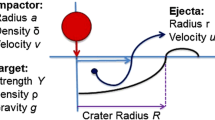Abstract
The cratering event produced by the Deep Impact mission is a unique experimental opportunity, beyond the capability of Earth-based laboratories with regard to the impacting energy, target material, space environment, and extremely low-gravity field. Consequently, impact cratering theory and modeling play an important role in this mission, from initial inception to final data analysis. Experimentally derived impact cratering scaling laws provide us with our best estimates for the crater diameter, depth, and formation time: critical in the mission planning stage for producing the flight plan and instrument specifications. Cratering theory has strongly influenced the impactor design, producing a probe that should produce the largest possible crater on the surface of Tempel 1 under a wide range of scenarios. Numerical hydrocode modeling allows us to estimate the volume and thermodynamic characteristics of the material vaporized in the early stages of the impact. Hydrocode modeling will also aid us in understanding the observed crater excavation process, especially in the area of impacts into porous materials. Finally, experimentally derived ejecta scaling laws and modeling provide us with a means to predict and analyze the observed behavior of the material launched from the comet during crater excavation, and may provide us with a unique means of estimating the magnitude of the comet’s gravity field and by extension the mass and density of comet Tempel 1.
Similar content being viewed by others
References
Anderson, C. E.: 1987, Int. J. Impact Eng. 5, 33.
Anderson, J. L. B., Schultz, P. H., and Heineck, J. T.: 2003, J. Geophys. Res. (Planets) 108, 13.
Artemieva, N. A. and Ivanov, B. A.: 2001, Lunar Planet. Inst. Conf. Abst. 32, 1431.
Asphaug, E. and Benz, W.: 1994, Nature 370, 120.
Brandt, J. C. and Chapman, R. D.: 2004, Introduction to Comets, Cambridge University Press, Cambridge, USA.
Brownlee, D. E., Horz, F., Newburn, R. L., Zolensky, M., Duxbury, T. C., Sandford, S., et al.: 2004, Science 304, 1764.
Chamberlain, J. W. and Hunten, D. M.: 1987, Theory of Planetary Atmospheres, Academic Press, San Diego.
Cintala, M. J., Berthoud, L., and Hörz, F.: 1999, Meteor. Planet. Sci. 34, 605.
Collins, G. C., Melosh, H. J., and Ivanov, B. A.: 2004, Meteor. Planet. Sci. 39, 217.
Croft, S. K.: 1981, in Schultz, P. H. and Merrill, R. B. (eds.), Multi-Ring Basins, Pergamon Press, New York, p. 207.
Geissler, P., Petit, J. M., Durda, D. D., Greenberg, R., Bottke, W. F., and Nolan, M. C.: 1996, Icarus 120, 140.
Grady, D. E. and Kipp, M. E.: 1987, in Atkinson, B. K. (ed.), Fracture Mechanics of Rock, Academic Press, San Diego, p. 429.
Heiken, G. H., Vaniman, D. T., and French, B. M.: 1991, Lunar Sourcebook, Cambridge University Press, Cambridge, USA.
Holsapple, K. A.: 1980, Lunar and Planetary Science Conference, Vol. 11, Pergamon Press, New York, p. 2379.
Holsapple, K. A. and Schmidt, R. M.: 1982, J. Geophys. Res. 87, 1849.
Housen, K. R., Schmidt, R. M., and Holsapple, K.A.: 1983, J. Geophys. Res. 88, 2485.
Jessberger, E. K.: 1999, Space Sci. Rev. 90, 91.
Larson, D. B.: 1977, The Relationship of Rock Properties to Explosive Energy Coupling, UCRL-52204, University of California Research Labs.
Lisse, C. M., A’Hearn, M. F., Fernandez, Y. R., McLaughlin, S. A., Meech, K. J., and Walker, R. J.: 2004, Icarus, in press.
Love, S. G., Hörz, F., and Brownlee, D. E.: 1993, Icarus 105, 216.
McGlaun, J. M., Thompson, S. I., and Elrick, M. G.: 1990, Int. J. Impact Eng. 10, 351.
Melosh, H. J.: 1989, Impact Cratering: A Geologic Process, Oxford University Press, New York.
Melosh, H. J.: 2000, Lunar Planet. Inst. Conf. Abst. 31, 1903.
Melosh, H. J. and Ivanov, B. A.: 1999, Ann. Rev. Earth Planet. Sci. 27, 385.
Nolan, M. C., Asphaug, E., Melosh, H. J., and Greenberg, R.: 1996, Icarus 124, 359.
Nordyke, M. D.: 1962, J. Geophy. Res. 67, 1965.
Peale, S. J.: 1989, Icarus 82, 36.
Pierazzo, E., Artemieva, N. A., and Spitale, J. N.: 2001, ESF-IMPACT 5: Catastrophic Events and Mass Extinctions: Impacts and Beyond, Granada, Spain.
Poorman, K. L. and Piekutowski, A. J.: 1995, Int. J. Impact Eng. 17, 639.
Rubin, M. B., Vorobiev, O. Y., and Glenn, L. A.: 2000, Int. J. Solids Struc. 37, 1841.
Sagdeev, R. Z., Elyasberg, P. E., and Moroz, V. I.: 1988, Nature 331, 240.
Scotti, J. and Melosh, H. J.: 1993, Nature 365, 733.
Schmidt, R. M. and Housen, K. R.: 1987, Int. J. Impact Eng. 5, 543.
Schultz, P. H. Anderson, J. L. B., and Heineck, J. T.: 2002, Lunar Planet. Inst. Conf. Abst. 33, 1875.
Schultz, P. H. and Ernst, C.: 2005, Space Sci. Rev., this volume.
Shuvalov, V. V.: 1999, Shock Waves 9, 381.
Taylor, S. R.: 1982, Planetary Science: A Lunar Perspective, Lunar and Planetary Institute, Texas.
Thompson, S. L. and Lauson, H. S.: 1972, Improvements in the Chart-D radiation hydrodynamic code III: Revised analytical equation of state, Sandia National Laboratories Report SC-RR-710714, Albuquerque, New Mexico, 119 pp.
Werner, R. A.: 1994, Celest. Mech. Dyn. Astron. 59, 253.
Wroth, C. P. and Bassett, R. H.: 1983, Géotechnique 33, 32.
Wünnemann, K. and Ivanov, B. A.: 2003, Planet. Space Sci. 51, 831.
Author information
Authors and Affiliations
Corresponding author
Rights and permissions
About this article
Cite this article
Richardson, J.E., Melosh, H.J., Artemeiva, N.A. et al. Impact Cratering Theory and Modeling for the Deep Impact Mission: From Mission Planning to Data Analysis. Space Sci Rev 117, 241–267 (2005). https://doi.org/10.1007/s11214-005-3393-5
Received:
Accepted:
Issue Date:
DOI: https://doi.org/10.1007/s11214-005-3393-5




